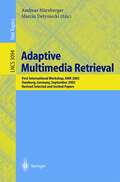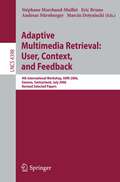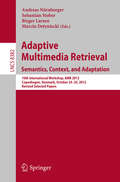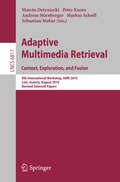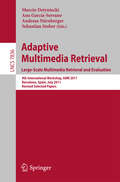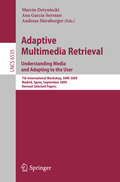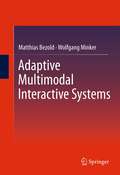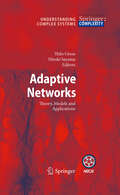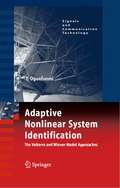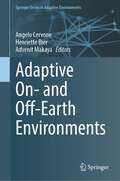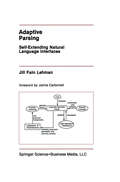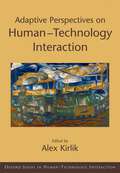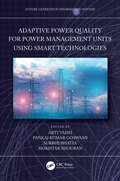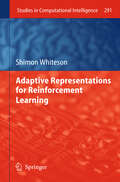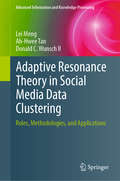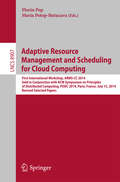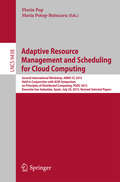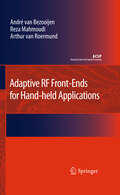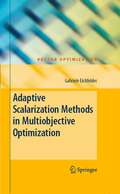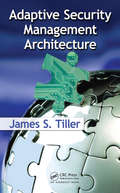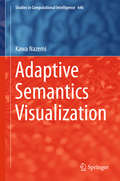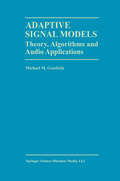- Table View
- List View
Adaptive Multimedia Retrieval: First International Workshop, AMR 2003, Hamburg, Germany, September 15-16, 2003, Revised Selected and Invited Papers (Lecture Notes in Computer Science #3094)
by Andreas Nürnberger Marcin DetynieckiThis book is an extended collection of contributions that wereoriginally subm- ted to the 1st International Workshop on Adaptive Multimedia Retrieval (AMR 2003), which was organized as part of the 26th German Conference on Arti?cial Intelligence (KI 2003),and held during September 15–18,2003at the University of Hamburg, Germany. Motivated by the overall success of the workshop – as revealed by the stimulating atmosphere during the workshop and the number of very interested and active participants – we ?nally decided to edit a book based on revised papers that were initially submitted to the workshop. Furthermore, we invited some more introductory contributions in order to be able to provide a conclusive book on current topics in the area of adaptive multimedia retrieval systems. We hope that we were able to put together a stimulating collection of articles for the interested reader. We like to thank the organizationcommittee of the 26th German Conference on Arti?cial Intelligence (KI 2003) for providing the setting and the admin- trative support in realizing this workshop as part of their program. Especially, we like to thank Christopher Habel for promoting the workshop as part of the conference program and Andreas Gun ¨ ther for his kind support throughout the organization process.
Adaptive Multimedia Retrieval: 4th International Workshop, AMR 2006, Geneva, Switzerland, July, 27-28, 2006, Revised Selected Papers (Lecture Notes in Computer Science #4398)
by Andreas Nürnberger Marcin Detyniecki Stéphane Marchand-Maillet Eric BrunoThis book constitutes the thoroughly refereed post-proceedings of the 4th International Workshop on Adaptive Multimedia Retrieval, AMR 2006, held in Geneva, Switzerland in July 2006. The papers cover ontology-based retrieval and annotation, ranking and similarity measurements, music information retrieval, visual modeling, adaptive retrieval, structuring multimedia, as well as user integration and profiling.
Adaptive Multimedia Retrieval: 10th International Workshop, AMR 2012, Copenhagen, Denmark, October 24-25, 2012, Revised Selected Papers (Lecture Notes in Computer Science #8382)
by Andreas Nürnberger Sebastian Stober Birger Larsen Marcin DetynieckiThis book constitutes the thoroughly refereed post-conference proceedings of the 10th International Conference on Adaptive Multimedia Retrieval, AMR 2012, held in Copenhagen, Denmark, in October 2012.The 17 revised full papers presented were carefully reviewed and selected from numerous submissions. The papers cover topics of state of the art contributions, features and classification, location context, language and semantics, music retrieval, and adaption and HCI.
Adaptive Multimedia Retrieval. Context, Exploration and Fusion: 8th International Workshop, AMR 2010, Linz, Austria, August 17-18, 2010. Revised Selected Papers (Lecture Notes in Computer Science #6817)
by Marcin Detyniecki Peter Knees Andreas Nürnberger Markus Schedl Sebastian StoberThis book constitutes the refereed proceedings of the 8th International Conference on Adaptive Multimedia Retrieval, AMR 2010, held in Linz, Austria, in August 2010. The 14 revised full papers and the invited contribution presented were carefully reviewed and selected from numerous submissions. The papers are organized in topical sections on Context-based personalization; media information fusion; video retrieval; audio and music retrieval; adaptive similarities; and finding and organizing.
Adaptive Multimedia Retrieval. Large-Scale Multimedia Retrieval and Evaluation: 9th International Workshop, AMR 2011, Barcelona, Spain, July 18-19, 2011, Revised Selected Papers (Lecture Notes in Computer Science #7836)
by Marcin Detyniecki Ana García-Serrano Andreas Nürnberger Sebastian StoberThis book constitutes the refereed post-proceedings of the 9th International Conference on Adaptive Multimedia Retrieval, AMR 2011, held in Barcelona, Spain, in July 2011. The 9 revised full papers and the invited contribution presented were carefully reviewed and selected from numerous submissions. The papers cover topics ranging from theoretical work to practical implementations and its evaluation, most of them dealing with audio or music media. They are organized in topical sections on evaluation and user studies, audio and music, image retrieval, and similarity and music.
Adaptive Multimedia Retrieval. Understanding Media and Adapting to the User: 7th International Workshop, AMR 2009, Madrid, Spain, September 24-25, 2009, Revised Selected Papers (Lecture Notes in Computer Science #6535)
by Marcin Detyniecki Ana García-Serrano Andreas NürnbergerThis book constitutes the refereed proceedings of the 7th International Conference on Adaptive Multimedia Retrieval, AMR 2009, held in Madrid, Spain, in September 2009. The 12 revised full papers and the invited contribution presented were carefully reviewed. The papers are organized in topical sections on grasping multimedia streams; pinpointing music; adapting distances; understanding images; and around the user.
Adaptive Multimodal Interactive Systems
by Matthias Bezold Wolfgang MinkerAdaptive Multimodal Interactive Systems introduces a general framework for adapting multimodal interactive systems and comprises a detailed discussion of each of the steps required for adaptation. This book also investigates how interactive systems may be improved in terms of usability and user friendliness while describing the exhaustive user tests employed to evaluate the presented approaches. After introducing general theory, a generic approach for user modeling in interactive systems is presented, ranging from an observation of basic events to a description of higher-level user behavior. Adaptations are presented as a set of patterns similar to those known from software or usability engineering.These patterns describe recurring problems and present proven solutions. The authors include a discussion on when and how to employ patterns and provide guidance to the system designer who wants to add adaptivity to interactive systems. In addition to these patterns, the book introduces an adaptation framework, which exhibits an abstraction layer using Semantic Web technology.Adaptations are implemented on top of this abstraction layer by creating a semantic representation of the adaptation patterns. The patterns cover both graphical interfaces as well as speech-based and multimodal interactive systems.
Adaptive Networks: Theory, Models and Applications (Understanding Complex Systems)
by Thilo Gross Hiroki SayamaAdding one and one makes two, usually. But sometimes things add up to more than the sum of their parts. This observation, now frequently expressed in the maxim “more is different”, is one of the characteristic features of complex systems and, in particular, complex networks. Along with their ubiquity in real world systems, the ability of networks to exhibit emergent dynamics, once they reach a certain size, has rendered them highly attractive targets for research. The resulting network hype has made the word “network” one of the most in uential buzzwords seen in almost every corner of science, from physics and biology to economy and social sciences. The theme of “more is different” appears in a different way in the present v- ume, from the viewpoint of what we call “adaptive networks.” Adaptive networks uniquely combine dynamics on a network with dynamical adaptive changes of the underlying network topology, and thus they link classes of mechanisms that were previously studied in isolation. Here adding one and one certainly does not make two, but gives rise to a number of new phenomena, including highly robust se- organization of topology and dynamics and other remarkably rich dynamical beh- iors.
Adaptive Nonlinear System Identification: The Volterra and Wiener Model Approaches (Signals and Communication Technology)
by Tokunbo OgunfunmiFocuses on System Identification applications of the adaptive methods presented. but which can also be applied to other applications of adaptive nonlinear processes. Covers recent research results in the area of adaptive nonlinear system identification from the authors and other researchers in the field.
Adaptive On- and Off-Earth Environments (Springer Series in Adaptive Environments)
by Angelo Cervone Henriette Bier Advenit MakayaThis volume investigates the challenges and opportunities for designing, manufacturing and operating off-Earth infrastructures in order to establish adaptive human habitats. The adaptive aspects are considered with respect to the development of adequate infrastructures designed to support human activities. Given the limitations in bringing materials from Earth, utilisation of in-situ resources is crucial for establishing and maintaining these infrastructures.Adaptive on-and off-Earth Environments focuses, among other aspects, on the design, production, and operation processes required to build and maintain such off-Earth infrastructures, while heavily relying on In-Situ Resource Utilisation (ISRU). Such design, production, and operation processes integrate cyber-physical approaches developed and tested on Earth. The challenge is to adapt on-Earth approaches to off-Earth applications aiming at technology advancement and ultimately transfer from on- to off-Earth research. Thischallenge is addressed with contributions from various disciplines ranging from power generation to architecture, construction, and materials engineering involving ISRU for manufacturing processes. All chapters, related to these disciplines, are structured with an emphasis on computing and adaptivity of on-Earth technology to off-Earth applications and vice versa to serve society at large.
Adaptive Parsing: Self-Extending Natural Language Interfaces (The Springer International Series in Engineering and Computer Science #161)
by Jill Fain LehmanAs the computer gradually automates human-oriented tasks in multiple environ ments, the interface between computers and the ever-wider population of human users assumes progressively increasing importance. In the office environment, for instance, clerical tasks such as document filing and retrieval, and higher-level tasks such as scheduling meetings, planning trip itineraries, and producing documents for publication, are being partially or totally automated. The range of users for office oriented software includes clerks, secretaries, and businesspersons, none of whom are predominantly computer literate. The same phenomenon is echoed in the factory production line, in the securities trading floor, in government agencies, in educa tional institutions, and even in the home. The arcane command languages of yes teryear have proven too high a barrier for smooth acceptance of computerized func tions into the workplace, no matter how useful these functions may be. Computer naive users simply do not take the time to learn intimidating and complex computer interfaces. In order to place the functionality of modem computers at the disposition of diverse user populations, a number of different approaches have been tried, many meeting with a significant measure of success, to wit: special courses to train users in the simpler command languages (such as MS-DOS), designing point-and-click menu/graphics interfaces that require much less user familiarization (illustrated most clearly in the Apple Macintosh), and interacting with the user in his or her language of choice.
Adaptive Perspectives on Human-Technology Interaction: Methods and Models for Cognitive Engineering and Human-Computer Interaction (Human Technology Interaction Series)
by Alex KirlikIn everyday life, and particularly in the modern workplace, information technology and automation increasingly mediate, augment, and sometimes even interfere with how humans interact with their environment. How to understand and support cognition in human-technology interaction is both a practically and socially relevant problem. The chapters in this volume frame this problem in adaptive terms: How are behavior and cognition adapted, or perhaps ill-adapted, to the demands and opportunities of an environment where interaction is mediated by tools and technology? The authors draw heavily on the work of Egon Brunswik, a pioneer in ecological and cognitive psychology, as well as on modern refinements and extensions of Brunswikian ideas, including Hammond's Social Judgment Theory, Gigerenzer's Ecological Rationality and Anderson's Rational Analysis. Inspired by Brunswik's view of cognition as "coming to terms" with the "casual texture" of the external world, the chapters in this volume provide quantitative and computational models and measures for studying how people come to terms with an increasingly technological ecology, and provide insights for supporting cognition and performance through design, training, and other interventions. The methods, models, and measures presented in this book provide timely and important resources for addressing problems in the rapidly growing field of human-technology interaction. The book will be of interest to researchers, students, and practitioners in human factors, cognitive engineering, human-computer interaction, judgment and decision making, and cognitive science.
Adaptive Perspectives on Human-Technology Interaction: Methods and Models for Cognitive Engineering and Human-Computer Interaction (Human Technology Interaction Series)
by Alex KirlikIn everyday life, and particularly in the modern workplace, information technology and automation increasingly mediate, augment, and sometimes even interfere with how humans interact with their environment. How to understand and support cognition in human-technology interaction is both a practically and socially relevant problem. The chapters in this volume frame this problem in adaptive terms: How are behavior and cognition adapted, or perhaps ill-adapted, to the demands and opportunities of an environment where interaction is mediated by tools and technology? The authors draw heavily on the work of Egon Brunswik, a pioneer in ecological and cognitive psychology, as well as on modern refinements and extensions of Brunswikian ideas, including Hammond's Social Judgment Theory, Gigerenzer's Ecological Rationality and Anderson's Rational Analysis. Inspired by Brunswik's view of cognition as "coming to terms" with the "casual texture" of the external world, the chapters in this volume provide quantitative and computational models and measures for studying how people come to terms with an increasingly technological ecology, and provide insights for supporting cognition and performance through design, training, and other interventions. The methods, models, and measures presented in this book provide timely and important resources for addressing problems in the rapidly growing field of human-technology interaction. The book will be of interest to researchers, students, and practitioners in human factors, cognitive engineering, human-computer interaction, judgment and decision making, and cognitive science.
Adaptive Power Quality for Power Management Units using Smart Technologies (Future Generation Information Systems)
by Arti Vaish Pankaj Kumar Goswami Surbhi Bhatia Mokhtar ShouranThis book covers issues associated with smart systems due to the presence of onboard nonlinear components. It discusses the advanced architecture of smart systems for power management units. It explores issues of power management and identifies hazardous signals in the power management units of smart devices. It Presents adaptive artificial intelligence and machine learning-based control strategies. Discusses advanced simulations and data synthesis for various power management issues. Showcases solutions to the uncertainty and reliability issues in power management units. Identifies new power quality challenges in smart devices. Explains hybrid active power filters, shunt hybrid active power filters, and the industrial internet of things in power quality management. This book comprehensively discusses advancements of traditional electrical grids, the benefits of smart grids to customers and stakeholders, properties of smart grids, smart grid architecture, smart grid communication, and smart grid security. It further covers the architecture of advance power management units (PMU) of smart devices, and the identification of harmonic distortions with respect to various sensor-based technology. It will serve as an ideal reference text for senior undergraduate and graduate students, and academic researchers in fields including electrical engineering, electronics, communications engineering, and computer engineering.
Adaptive Power Quality for Power Management Units using Smart Technologies (Future Generation Information Systems)
by Arti Vaish Pankaj Kumar Goswami Surbhi Bhatia Mokhtar ShouranThis book covers issues associated with smart systems due to the presence of onboard nonlinear components. It discusses the advanced architecture of smart systems for power management units. It explores issues of power management and identifies hazardous signals in the power management units of smart devices. It Presents adaptive artificial intelligence and machine learning-based control strategies. Discusses advanced simulations and data synthesis for various power management issues. Showcases solutions to the uncertainty and reliability issues in power management units. Identifies new power quality challenges in smart devices. Explains hybrid active power filters, shunt hybrid active power filters, and the industrial internet of things in power quality management. This book comprehensively discusses advancements of traditional electrical grids, the benefits of smart grids to customers and stakeholders, properties of smart grids, smart grid architecture, smart grid communication, and smart grid security. It further covers the architecture of advance power management units (PMU) of smart devices, and the identification of harmonic distortions with respect to various sensor-based technology. It will serve as an ideal reference text for senior undergraduate and graduate students, and academic researchers in fields including electrical engineering, electronics, communications engineering, and computer engineering.
Adaptive Representations for Reinforcement Learning (Studies in Computational Intelligence #291)
by Shimon WhitesonThis book presents new algorithms for reinforcement learning, a form of machine learning in which an autonomous agent seeks a control policy for a sequential decision task. Since current methods typically rely on manually designed solution representations, agents that automatically adapt their own representations have the potential to dramatically improve performance. This book introduces two novel approaches for automatically discovering high-performing representations. The first approach synthesizes temporal difference methods, the traditional approach to reinforcement learning, with evolutionary methods, which can learn representations for a broad class of optimization problems. This synthesis is accomplished by customizing evolutionary methods to the on-line nature of reinforcement learning and using them to evolve representations for value function approximators. The second approach automatically learns representations based on piecewise-constant approximations of value functions. It begins with coarse representations and gradually refines them during learning, analyzing the current policy and value function to deduce the best refinements. This book also introduces a novel method for devising input representations. This method addresses the feature selection problem by extending an algorithm that evolves the topology and weights of neural networks such that it evolves their inputs too. In addition to introducing these new methods, this book presents extensive empirical results in multiple domains demonstrating that these techniques can substantially improve performance over methods with manual representations.
Adaptive Resonance Theory in Social Media Data Clustering: Roles, Methodologies, and Applications (Advanced Information and Knowledge Processing)
by Lei Meng Ah-Hwee Tan Donald C. Wunsch IISocial media data contains our communication and online sharing, mirroring our daily life. This book looks at how we can use and what we can discover from such big data:Basic knowledge (data & challenges) on social media analyticsClustering as a fundamental technique for unsupervised knowledge discovery and data miningA class of neural inspired algorithms, based on adaptive resonance theory (ART), tackling challenges in big social media data clustering Step-by-step practices of developing unsupervised machine learning algorithms for real-world applications in social media domainAdaptive Resonance Theory in Social Media Data Clustering stands on the fundamental breakthrough in cognitive and neural theory, i.e. adaptive resonance theory, which simulates how a brain processes information to perform memory, learning, recognition, and prediction.It presents initiatives on the mathematical demonstration of ART’s learning mechanisms in clustering, and illustrates how to extend the base ART model to handle the complexity and characteristics of social media data and perform associative analytical tasks.Both cutting-edge research and real-world practices on machine learning and social media analytics are included in the book and if you wish to learn the answers to the following questions, this book is for you:How to process big streams of multimedia data?How to analyze social networks with heterogeneous data?How to understand a user’s interests by learning from online posts and behaviors?How to create a personalized search engine by automatically indexing and searching multimodal information resources? .
Adaptive Resource Management and Scheduling for Cloud Computing: First International Workshop, ARMS-CC 2014, held in Conjunction with ACM Symposium on Principles of Distributed Computing, PODC 2014, Paris, France, July 15, 2014, Revised Selected Papers (Lecture Notes in Computer Science #8907)
by Florin Pop Maria Potop-ButucaruThis book constitutes the thoroughly refereed post-conference proceedings of the First International Workshop on Adaptive Resource Management and Scheduling for Cloud Computing, ARMS-CC 2014, held in Conjunction with ACM Symposium on Principles of Distributed Computing, PODC 2014, in Paris, France, in July 2014. The 14 revised full papers (including 2 invited talks) were carefully reviewed and selected from 29 submissions and cover topics such as scheduling methods and algorithms, services and applications, fundamental models for resource management in the cloud.
Adaptive Resource Management and Scheduling for Cloud Computing: Second International Workshop, ARMS-CC 2015, Held in Conjunction with ACM Symposium on Principles of Distributed Computing, PODC 2015, Donostia-San Sebastián, Spain, July 20, 2015, Revised Selected Papers (Lecture Notes in Computer Science #9438)
by Florin Pop Maria Potop-ButucaruThis book constitutes the thoroughly refereed post-conference proceedings of the Second International Workshop on Adaptive Resource Management and Scheduling for Cloud Computing, ARMS-CC 2015, held in Conjunction with ACM Symposium on Principles of Distributed Computing, PODC 2015, in Donostia-San Sebastián, Spain, in July 2015. The 12 revised full papers, including 1 invited paper, were carefully reviewed and selected from 24 submissions. The papers have identified several important aspects of the problem addressed by ARMS-CC: self-* and autonomous cloud systems, cloud quality management and service level agreement (SLA), scalable computing, mobile cloud computing, cloud computing techniques for big data, high performance cloud computing, resource management in big data platforms, scheduling algorithms for big data processing, cloud composition, federation, bridging, and bursting, cloud resource virtualization and composition, load-balancing and co-allocation, fault tolerance, reliability, and availability of cloud systems.
Adaptive RF Front-Ends for Hand-held Applications (Analog Circuits and Signal Processing)
by Andre van Bezooijen Reza Mahmoudi Arthur H.M. van RoermundThe RF front-end – antenna combination is a vital part of a mobile phone because its performance is very relevant to the link quality between hand-set and cellular network base-stations. The RF front-end performance suffers from changes in operating environment, like hand-effects, that are often unpredictable. Adaptive RF Front-Ends for Hand-Held Applications presents an analysis on the impact of fluctuating environmental parameters. In order to overcome undesired behavior two different adaptive control methods are treated that make RF frond-ends more resilient: adaptive impedance control, and adaptive power control. Several adaptive impedance control techniques are discussed, using a priori knowledge on matching network properties, in order to simplify robust 2-dimensional control. A generic protection concept is presented, based on adaptive power control, which improves the ruggedness of a power amplifier or preserves its linearity under extremes. It comprises over-voltage, over-temperature, and under-voltage protection.
Adaptive Scalarization Methods in Multiobjective Optimization (Vector Optimization)
by Gabriele EichfelderAdaptive Security Management Architecture
by James S. TillerThis volume enables security professionals to structure the best security program designed to meet the complex needs of an entire organization, taking into account the organization's business goals as well as the surrounding controls, processes, and units already in existence. The book explains how an organization can develop an adaptive security program closely aligned to business needs, making it an enabling force that helps the organization achieve its goals and objectives. It presents the end product of a successful security management system and examines the finer points of how it can be accomplished.
Adaptive Security Management Architecture
by James S. TillerThis volume enables security professionals to structure the best security program designed to meet the complex needs of an entire organization, taking into account the organization's business goals as well as the surrounding controls, processes, and units already in existence. The book explains how an organization can develop an adaptive security program closely aligned to business needs, making it an enabling force that helps the organization achieve its goals and objectives. It presents the end product of a successful security management system and examines the finer points of how it can be accomplished.
Adaptive Semantics Visualization (Studies in Computational Intelligence #646)
by Kawa NazemiThis book introduces a novel approach for intelligent visualizations that adapts the different visual variables and data processing to human’s behavior and given tasks. Thereby a number of new algorithms and methods are introduced to satisfy the human need of information and knowledge and enable a usable and attractive way of information acquisition. Each method and algorithm is illustrated in a replicable way to enable the reproduction of the entire “SemaVis” system or parts of it. The introduced evaluation is scientifically well-designed and performed with more than enough participants to validate the benefits of the methods. Beside the introduced new approaches and algorithms, readers may find a sophisticated literature review in Information Visualization and Visual Analytics, Semantics and information extraction, and intelligent and adaptive systems. This book is based on an awarded and distinguished doctoral thesis in computer science.
Adaptive Signal Models: Theory, Algorithms, and Audio Applications (The Springer International Series in Engineering and Computer Science #467)
by Michael M. GoodwinAdaptive Signal Models: Theory, Algorithms and Audio Applications presents methods for deriving mathematical models of natural signals. The introduction covers the fundamentals of analysis-synthesis systems and signal representations. Some of the topics in the introduction include perfect and near-perfect reconstruction, the distinction between parametric and nonparametric methods, the role of compaction in signal modeling, basic and overcomplete signal expansions, and time-frequency resolution issues. These topics arise throughout the book as do a number of other topics such as filter banks and multiresolution. The second chapter gives a detailed development of the sinusoidal model as a parametric extension of the short-time Fourier transform. This leads to multiresolution sinusoidal modeling techniques in Chapter Three, where wavelet-like approaches are merged with the sinusoidal model to yield improved models. In Chapter Four, the analysis-synthesis residual is considered; for realistic synthesis, the residual must be separately modeled after coherent components (such as sinusoids) are removed. The residual modeling approach is based on psychoacoustically motivated nonuniform filter banks. Chapter Five deals with pitch-synchronous versions of both the wavelet and the Fourier transform; these allow for compact models of pseudo-periodic signals. Chapter Six discusses recent algorithms for deriving signal representations based on time-frequency atoms; primarily, the matching pursuit algorithm is reviewed and extended. The signal models discussed in the book are compact, adaptive, parametric, time-frequency representations that are useful for analysis, coding, modification, and synthesis of natural signals such as audio. The models are all interpreted as methods for decomposing a signal in terms of fundamental time-frequency atoms; these interpretations, as well as the adaptive and parametric natures of the models, serve to link the various methods dealt with in the text. Adaptive Signal Models: Theory, Algorithms and Audio Applications serves as an excellent reference for researchers of signal processing and may be used as a text for advanced courses on the topic.
